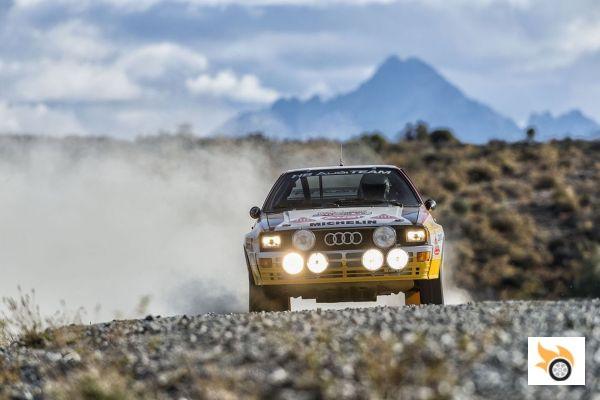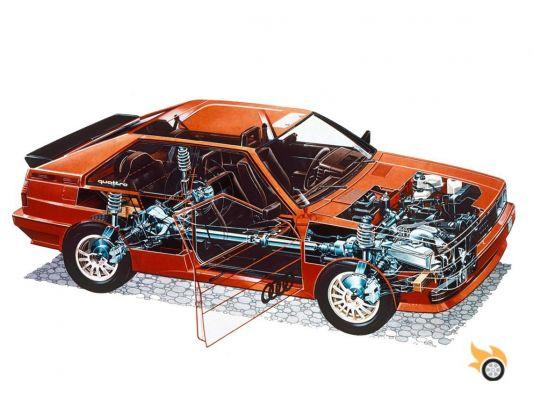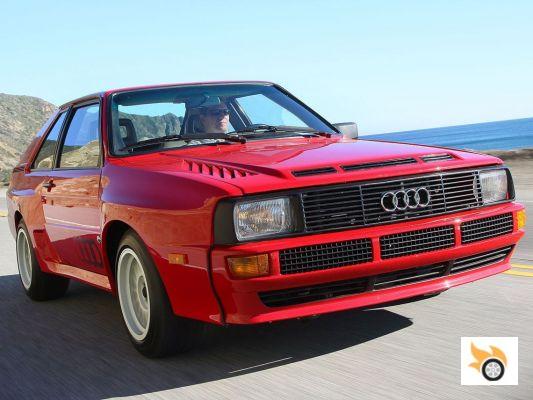 The Audi Quattro and its later evolution, the Sport Quattro, won 23 world championship rallies (between 1981 and 1985), winning two manufacturer's world titles for Audi (1982 and 1984) and giving the world championship to Hannu Mikola (1983) and Stig Blomqvist (1984).
The Audi Quattro and its later evolution, the Sport Quattro, won 23 world championship rallies (between 1981 and 1985), winning two manufacturer's world titles for Audi (1982 and 1984) and giving the world championship to Hannu Mikola (1983) and Stig Blomqvist (1984).
A front-wheel drive?!
In the late 1970s, when the original Audi Quattro was designed, it had no rivals. The last time a brand in the West had dared with an all-wheel drive car was the famous Jensen FF, in the 60s. Since then, no one had been interested in bringing an all-wheel drive car to the market (except Subaru, but initially only in Japan). And the fact is that four-wheel drive was something for specialists; outside of SUVs, nobody saw a commercial outlet for this system. Besides, as four-wheel drive was forbidden in competition, no brand was interested in developing such a transmission.
The placid Audi 80 sedan gave rise to the Audi Coupé, which served as the basis for the Audi Quattro.
However, in 1979, the FIA made two important changes to rally regulations. The first was to authorize the use of all-wheel drive in rallies, while with the second change inaugurated three categories to compete: Group N (production car), Group A (modified production car) and Group B (almost free category).
Group B allowed Audi to compete with its new and innovative all-wheel drive system Quattro, which gave a clear advantage in the rallies on broken surfaces and low grip (dirt, snow). The beauty of the Group B and what made it so successful was that only 200 units of a "civilian" version of the rally car needed to be built and sold to receive Group B homologation. The marques were no longer making a race car derived from a production model, they were doing the opposite. A competition car was designed -free from the obligations of a large series car- and then, if necessary, a street version was adapted to be sold to 200 customers.
Audi Quattro
All-wheel drive, four-wheel independent suspension ... and an engine hanging from the nose.
At that time Audi was developing a coupe derived from the Audi 80. It was a car with a classic architecture: front-wheel drive with McPherson struts in front and rigid axle at the rear. Nothing very racing, indeed. At the same time, in Audi were developing and were going to make an SUV for the German army, the Volkswagen Iltis. According to legend, it would be Ferdinand Piëch himself, after testing the Iltis, thought it would be a good idea to adapt the all-wheel drive to a sports car.
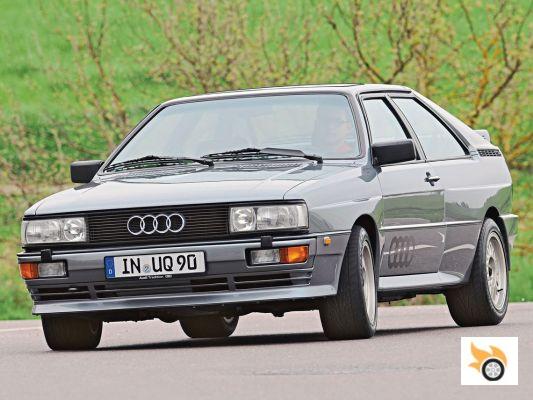 The Audi Quattro differs from the front-wheel drive coupe for its flared wings.
The Audi Quattro differs from the front-wheel drive coupe for its flared wings.
We do not really know whose idea it was, the question is that Walter Treser, responsible for developing the Quattro, made with his team a coupe all-wheel drive, which involved a McPherson suspension also for the rear axle, disc brakes on all four wheels and a 5-cylinder turbo engine of 2,144 cc, ie the Audi 200. At the same time a racing department is launched. And is that for Ferdinand Piëch, newcomer of the Porsche racing department, the salvation of Audi must go through the competition. And it must do so successfully. Otherwise, Audi would continue with an image of cheap car and at the orders of Volkswagen.
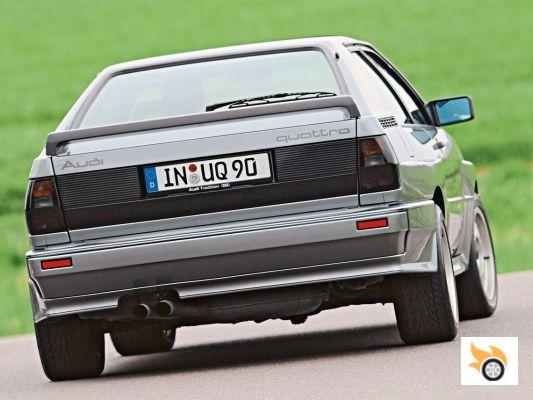 Throughout its commercial life (was produced until 1991), the sheet metal was not modified, but the headlights, grille, lights and bumpers, ie plastic parts.
Throughout its commercial life (was produced until 1991), the sheet metal was not modified, but the headlights, grille, lights and bumpers, ie plastic parts.
After the presentation at the Geneva Motor Show of the Audi Quattro, in March 1980, the original version of front-wheel drive (ie Audi Coupe), is presented in September of the same year. The Audi Quattro made its racing debut in the 1981 season. For 1982 had been made with the world title, but in 1983 lost it to Lancia and its brutal 037. And is that the first two years, Audi participated with a Group 4 car. It was not until 1983 that the engineers came up with the first evolution of the Ur-Quattro (as it is now known).
The first successes came with the Quattro in Group 4 (left), but it would soon become dominant in Group B (right).
While the Ur-Quattro was almost unbeatable on low-grip surfaces, as grip improved, other machines proved superior. On asphalt, for example, and sometimes even on dirt, the Lancia 037 was ahead despite being rear-wheel drive. The reason for this is that the Audi Quattro had the de facto architecture of a front-wheel drive: a heavy monocoque chassis, a long wheelbase and an engine in longitudinal position hanging in front of the front axle (about 61% of the weight of the car rested on the front axle...). The Lancia 037, on the other hand, was a pure racing machine with a tubular chassis, mid-rear engine and was a featherweight. An evolution was needed.
Sport Quattro
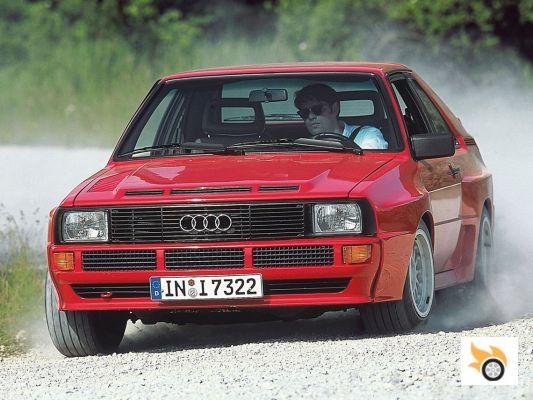 Under the direction of Roland Gumpert, the first evolution of the Ur-Quattro began to be developed in 1981. The initial objective was to propose a lighter and more agile car for rallies. However, Audi, like many other German brands, is not one of those who rushes to launch a car on the market or competition without first having thoroughly tested, hence it took a few years to bring to light the evolution. It is said that the first prototypes were already rolling in 1982, away from prying eyes in the Porsche test center in Weissach. If your boss is a member of the Porsche family, it helps if you're allowed to use certain facilities. The public launch came in September 1983. Only 4 units were built that year, but by 1984 more units were being built at a very leisurely pace.
Under the direction of Roland Gumpert, the first evolution of the Ur-Quattro began to be developed in 1981. The initial objective was to propose a lighter and more agile car for rallies. However, Audi, like many other German brands, is not one of those who rushes to launch a car on the market or competition without first having thoroughly tested, hence it took a few years to bring to light the evolution. It is said that the first prototypes were already rolling in 1982, away from prying eyes in the Porsche test center in Weissach. If your boss is a member of the Porsche family, it helps if you're allowed to use certain facilities. The public launch came in September 1983. Only 4 units were built that year, but by 1984 more units were being built at a very leisurely pace.
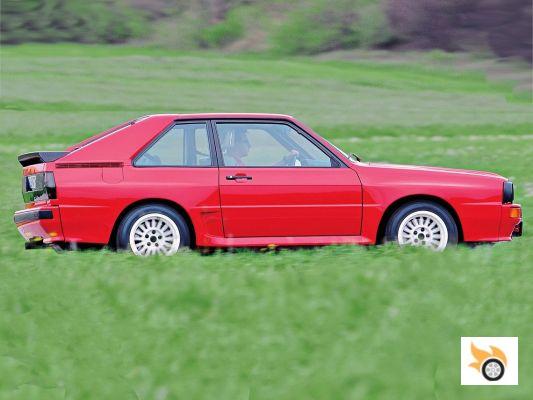 In profile, let's be honest, it's ugly... ugly as hell. The wheelbase lost 32 cm in the operation.
In profile, let's be honest, it's ugly... ugly as hell. The wheelbase lost 32 cm in the operation.
The aesthetics of the Sport Quattro is very similar to the Ur-quattro, but with a 32 cm shorter wheelbase! The passenger compartment becomes a 2+2. The result is a strange coupe with an overhang almost as long as the wheelbase and an almost truncated rear end. In fact, compared to the Ur-Quattro, the nose of the Sport Quattro is even longer. This was done so that a larger intercooler could be fitted. The front track grew by 10 cm and the car overall was 8 cm wider than the Ur-quattro. The wider wings were not the only new feature of the Quattro Sport. The body was still made of steel, but some panels, such as the bonnet or the roof, were made of fibreglass, carbon fibre and Kevlar. Bauer was in charge of the manufacturing, in external, but I can't help but think that the Audi people were a bit disappointed to see that the Sport Quattro was only 30 kg lighter than the original. Obviously, the Sport Quattro already shared little with the standard Audi Quattro, except for the windshield.
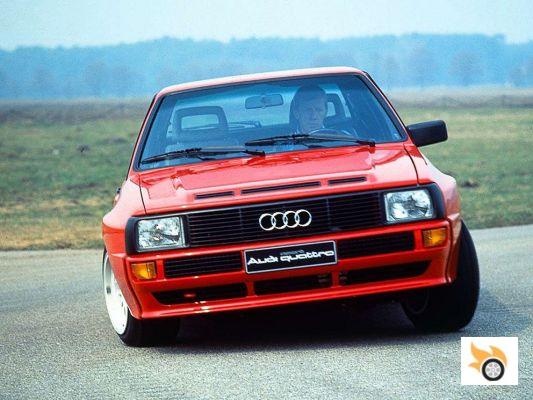
On the left, the 5-cylinder of the Quattro, on the right the Sport Quattro. The whole block is after the suspension turrets. Photo above: Walter Rörhl at the wheel of the Sport Quattro.
Compared to the Ur-Quattro, the main technical difference was in the new cylinder head. The 5-cylinder block was still the 2133 cc, but received a cylinder head with 4 valves per cylinder. In fact, the Sport Quattro was the first Audi to equip a cylinder head with 4 valves per cylinder, twin-shaft and alloy block. In addition, the new engine was equipped with a huge turbo KKK-K27 blowing at 1.05 bar. With respect to the Ur-quattro 200 hp, the standard Sport Quattro was a huge leap forward, as it erected 306 hp at 6,700 rpm and delivered 350 Nm at 3,700 rpm (compared to 285 Nm at 3,500 rpm of the Quattro).
When Audi unveiled the car, the racing department already knew that they could count on a car with at least 400 hp for competition and soon after 450 hp. More than enough to counter anything they could think of Lancia, Peugeot or Ford.
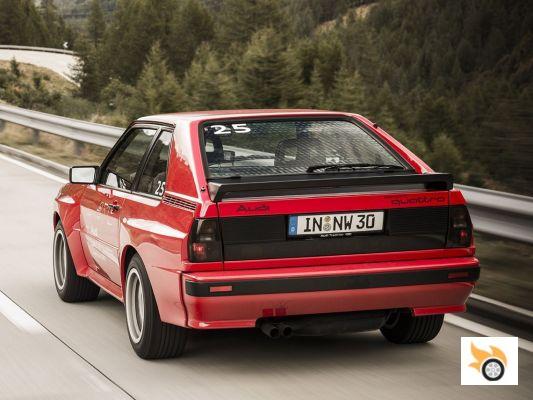
Recaro seats and dashboard derived from the Audi 100 for the Sport Quattro.
In addition to modifying some gearbox developments and suspension components, the Sport Quattro was fitted with larger diameter discs. As always in a car of such a sharp development and with such a complex manufacturing process, the selling price rose at the same rate as did its 5-cylinder. New, the car already cost 200,000 Deutsche Mark, i.e. twice as much as a normal Audi Quattro series. Of course, for that price, the Sport Quattro was better equipped than the "standard" Quattro. The dashboard was specific and derived from the Aud1 100. It also had ABS and equipped with beautiful Ronal wheels that today have become classics. Nowadays, none of the 200 units manufactured is under 350,000 euros. That's if you find one for sale, of course.
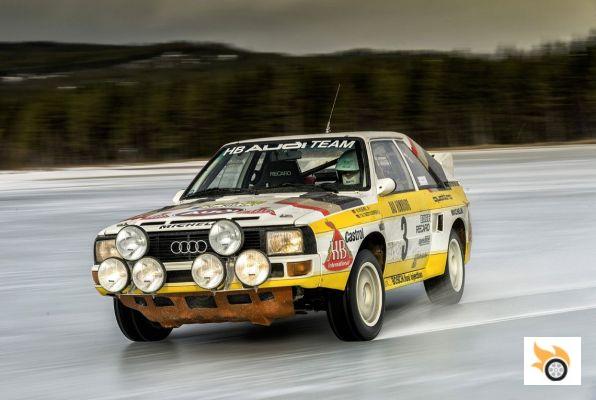
Sport Quattro E2
Somehow, Audi managed to homologate the Sport Quattro in Group B for May 1, 1984, when it had only made 50 cars of the minimum 200 that had to be made. I'm going to be wrong-headed, but Ferdinand Piëch, then at the helm of Audi, was already experienced in such subterfuge. After all, in 1969, when he was responsible for the Porsche 917 project, he already cheated to homologate the car. Recall that the authorities had to see live the 25 units required for homologation. In Porsche they did not have time to make them all, so some had wooden brake calipers, engine models, bodywork elements glued and began to peel off ... Let's say, Piëch always had more than one ace up his sleeve and should have achieved a similar feat with the Audi Sport Quattro.
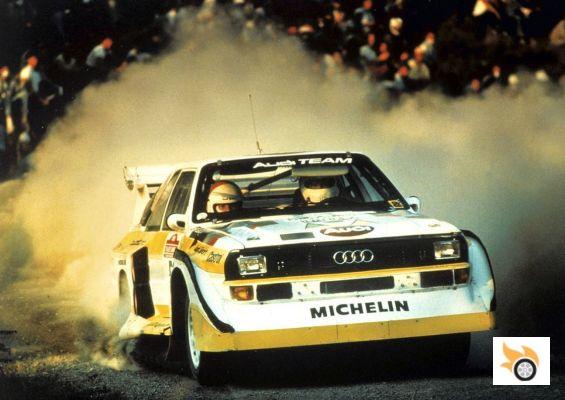 The Sport Quattro E2's "integral snowplow" is one of its most striking visual features.
The Sport Quattro E2's "integral snowplow" is one of its most striking visual features.
By the end of 1984, the team was eventually convinced that the car was too understeery. And that, for a rally car, even a 450bhp one, is not a good thing. In fact, the new model was so ill-suited to rallying that drivers like Stig Blomqvist openly complained about the car and preferred to race the previous model, even if it was less powerful. Soon, the team got back to work.
The car had to be much more agile and at the same time the aerodynamics had to be improved, as the car was not "flying properly". Some of the improvements were rejected by the FIA, and is that Audi failed to convince the body that had produced 20 new units of the "Evolution", known as E2 (for Evolution 2). In the end, the homologation group B arrives on July 1, 1985. The curious thing is that nobody is really sure that there were 20 Sport Quattro E2. It is known that the team used nine cars, but it is also true that in March 1986 Audi withdrew from Group B abruptly and subsequently used Sport Quattro in other competitions, such as Pikes Peak, and that could well be modified E2.
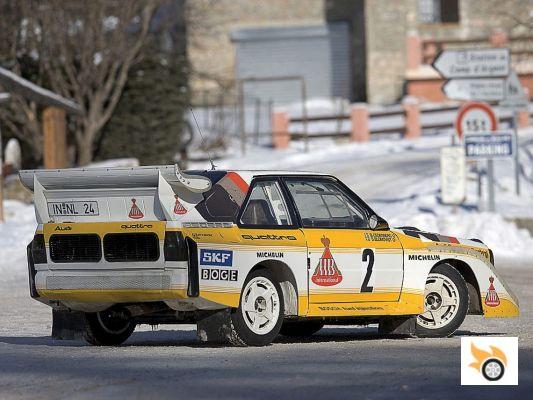 Between the rear lights, the two "trunk" extractors, where the radiators and intercoolers are located.
Between the rear lights, the two "trunk" extractors, where the radiators and intercoolers are located.
With a very bad weight distribution since its creation, the engineers had to improve the weight distribution in any way they could. The small trunk, would serve as a location for the cooling systems: radiators, intercoolers and alternator were now in the trunk. And all the heat came out directly through the two huge openings in the rear. Shortly afterwards, for reliability reasons, the alternator was moved back into the engine compartment. Roland Gumpert himself acknowledged in 1985 that the Sport Quattro had 58% of the weight on the front axle, while "the new car has 52%, so we are closer to the ideal 50/50 split".
As far as aerodynamics are concerned, it is worth remembering that the Group B cars didn't jump at some changes of gradient: they literally took off and landed dozens of metres further on. Hence the importance of the car flying straight and level (i.e. no nose up or nose down). Ari Vatanen understood this all too well when he crashed his Peugeot 205 T16. The modifications Audi brought to the E2 were such that the car was unrecognisable, but they also brought a definite plus in aerodynamic support. Gumpert said they generated "up to 500 kg of support, improving the turning ability of the tyres".
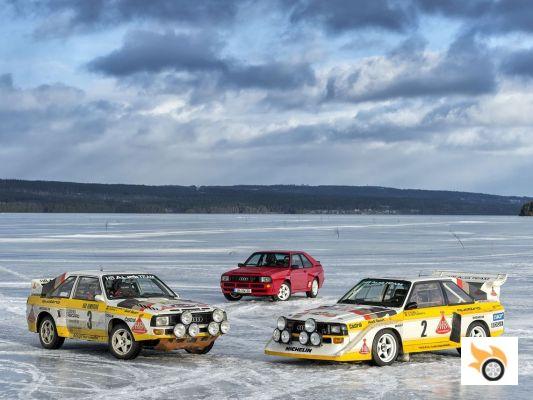 The three Sport Quattro: the homologation Sport Quattro (in the background), the Group B or S1 Sport Quattro (left) and the Sport Quattro E2 (right).
The three Sport Quattro: the homologation Sport Quattro (in the background), the Group B or S1 Sport Quattro (left) and the Sport Quattro E2 (right).
Milestone in rally history
The Audi Sport Quattro (Audi S2 in competition) is undoubtedly the most important of the Audi Quattro, because it was with him that in 1984 Audi won the double in the world rally championship: manufacturer and driver, with Stig Blomqvist. In general, the Audi Quattro marked a before and after in rallying.
It was not the most sophisticated of the participants at the time, but it was the first rally car to combine four-wheel drive with a turbo engine in competition. Later, Peugeot, with the 205 T16, and other brands decided to participate in Group B with machines developed specifically for this purpose: from Lancia (S4) to Rover (Metro 6R4) and Ford (RS200). Not to mention the aborted projects of Ferrari (288 GTO) and Porsche (959).
In short, if it wasn't for the successes of these Audi's, we wouldn't have what has been and is currently the norm in rallying: four-wheel drive and turbo engine. That is, we would have no Subaru Impreza STI, or Mitsubishi Lancer EVO or the current WRC. And to think that they started from a base that was the antithesis of a competition car...
